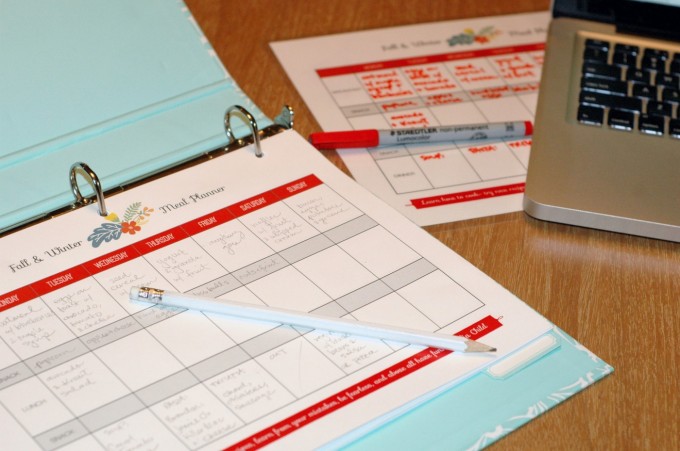A question that has snuck into a handful of conversations lately is, “Do you mind if I ask what your monthly food budget is?” I think a lot of moms wonder what others are spending on groceries each month, and if they are the only one spending more than they think they should be spending, or more than they can really afford. One thing I can say for sure, is that if you have been wondering that same thing, you are not alone.

I have no problem sharing my own spending with you all – on average, we spend $900-1000 per month on groceries for a family of six. A good month, with menu planning and shopping through our food co-op can mean $800. A bad month with no planning, and multiple trips to the store can mean $1200! We buy mostly high quality, organic food, and we don’t feel bad about spending a large percentage of our income on food to nourish our family. We call it preventative medicine! When we menu plan, we can decrease that by a hundred or two! I can help you with menu planning, yet there are other tips out there for decreasing your monthly spending on food.

Since I’m not the expert on all of these things, I decided to do share a few tips I’ve learned over the years, and then also share a quick roundup of articles that have tried and true tips on shaving dollars (or hundreds) from your monthly food spending. Read on to get started this month! Please do share your own tips, trials and questions in the comments!

TIPS FROM OUR HOME:
• Save Scraps :: Save vegetable scraps in a pail or ziploc in the freezer to add to soups or broth.
• Compost :: It’s true that this won’t actually save you anything on your grocery bill, but it will save you money during gardening season when you don’t have to buy organic compost or other amendments. And who wants to throw away food scraps with so many nutrients in them to sit in a landfill? Whatever doesn’t get saved for soup or broth, can go in the compost bucket. If you have fruit fly issues with your compost, consider a professional grade bin, or just an ice cream pail in the freezer…
• Grow Your Own :: Save, save, save by growing as much of your own food as possible. The easiest thing to start with is a vegetable and herb garden. If you can add preserving to the mix – freezing, canning, fermenting, etc. – you will save even more throughout the year.
• Menu Plan :: As I mentioned earlier, menu planning has saved our family hundreds of dollars a month. I’ve had a lot of fun teaching a few menu planning workshops, and developing our resources. You can get our menu planning documents with tips, printables, and more over in the shop. Our Tiny Peasant Pantry kids’ cooking, baking, and herbal learning resource also includes our menu planning resources.
• Join a Food Buying Club :: If you can, join a local food co-op or buying club to get access to wholesale pricing and build community at the same time.
• Shop at Your Local Farmers’ Market or Direct from a Farmer :: There are so many great products and prices at the market, or there’s the option if you can swing it to buy in bulk – or just on a regular basis – from your local farmers. This way, you truly know what you are buying, and you have the added benefit of getting to know and supporting your local farmers.
• Grow Your Own :: Save, save, save by growing as much of your own food as possible. The easiest thing to start with is a vegetable and herb garden. If you can add preserving to the mix – freezing, canning, fermenting, etc. – you will save even more throughout the year.
• Cook from Scratch :: Of course this isn’t an option for everyone, as some have tighter schedules than others. That said, it is a pretty simple thing to hydrate some beans in the crock pot and the savings over canned beans are significant. If you can switch over to ‘from scratch’ just one item a month, you will be well on your way to a whole foods diet on a budget! Some homemade foods to try include beans, bread, broth, butter, canned goods such as pickles, cereal, crackers, dips, dried fruits, salad dressing, vanilla, yogurt…
• Take Advantage of Sales :: When expensive items go on sale, we do our best to stock up. We only do this for items that we use regularly and consider staples in our pantry – things that we will be buying anyway, and that we know will get used up before the expiry date. There is no point in buying in bulk if the food will go to waste! We look for things like coconut oil, maple syrup, beans, grains, cheese, etc.
• Purchase Near Expiry Discounted Products :: We regularly snatch up the organic whipping cream that is discounted 50%, as well as cheese. I have found organic cheese on a significant discount because it was close to expiry and bought up almost the whole lot, took it home, grated it in the food processor, and tossed it in a ziploc bag in the freezer.
• Eat Leftovers :: This doesn’t have to mean having the same meal three days in a row. With a bit of creativity, you can find ways to repurpose foods – this can be as simple as using leftover turkey from Christmas or Thanksgiving dinner for hot turkey sandwiches one day, and soup another day. And maybe adding the leftover rice into that same soup (or save it for rice pudding, like we do!). Even better – plan to use leftovers when you menu plan – make extra rice at dinner for a breakfast of rice pudding!
• Batch Cook – when making a meal, double it and freeze the second serving – this will in the least save you time and overwhelm and can help use up ingredients that are about to spoil!

TIPS FROM OTHERS
1. Keeper of the Home :: What I Would Feed my Family on a Food Budget of $250
About a year ago, a friend of mine sent me this post where Stephanie, of Keeper of the Home, outlines how she would feed her family if she had a budget of just $250/month for a family of five! You read that right – and we’re talking a whole foods grocery list!
Also check out the second post in the series.
2. Food Renegade :: Eating Real Food on a Budget
Some great tips here for eating high quality foods for less. I love Kristen’s approach to not double-up on expensive animal proteins in a meal. We often have meals that include meat and cheese, egg and cheese – or all three, ahem.
3. Real Food For Less Money :: 5 Ways to Afford Real Food on a Meager Budget
I really like Millie’s down to earth approach to eating real food. It’s more of a “do what you can with what you have” approach. And really, that’s all each of us can do, isn’t it? Why stress over having a squeaky clean menu, rather than just starting where you are and working up from there?
This post was shared as a part of Thank Goodness It’s Monday, Natural Living Monday, Fat Tuesday, Fight Back Friday, Unprocessed Fridays, and Simply Natural Saturdays.

